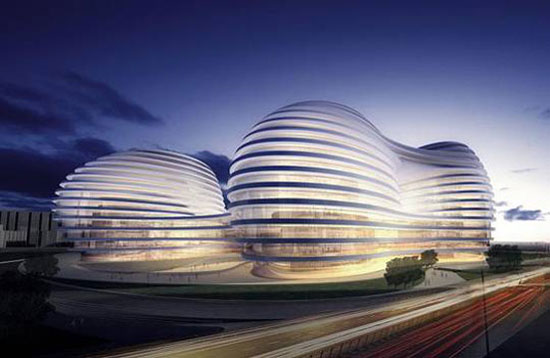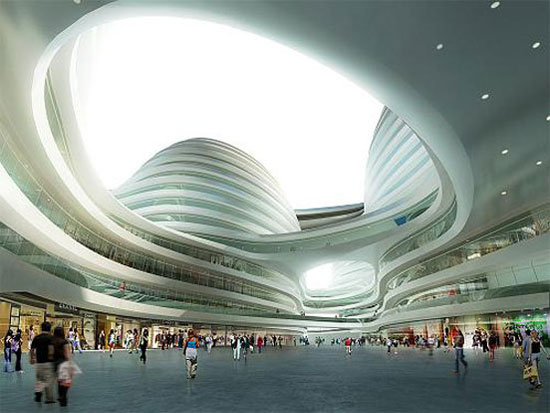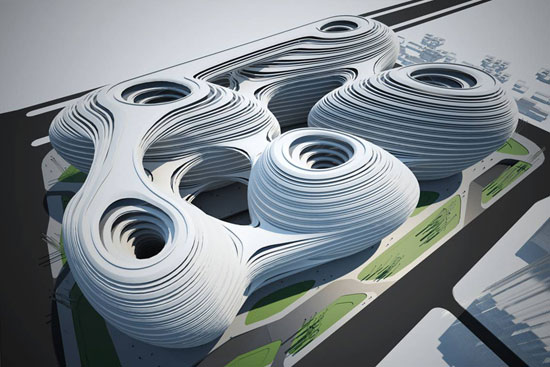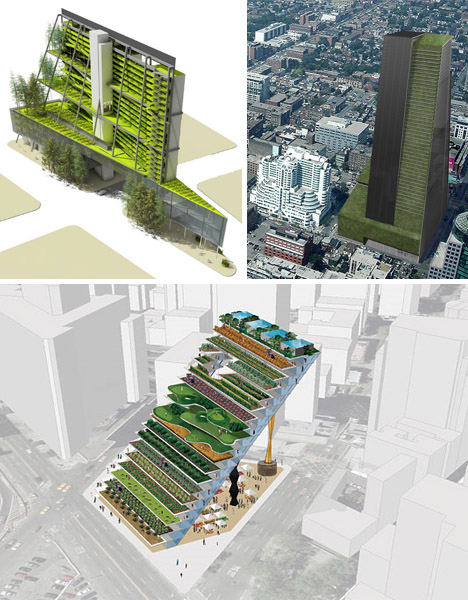Dynamic Flow of Spaces:
 |
| Zaha Hadid: Chaoyangmen SOHO III |
The most compelling spaces are often not static, individual spaces unto themselves, but part of a larger series of spaces. This pattern and its supporting patterns are about ways of creating spaces that flow into one another and invite you to explore and experience the set of spaces. Your goal should be to have a series of spaces reveal themselves self gradually in an experience that contains both order and mystery.
While it is important to have more static spaces where one feels perfectly comfortable to remain still, it is also important to have places where one is invited to move further.
 |
| Inner Courtyard |
When planning people's movement through space, orchestrate it so each space sets one up for the effect of next one. The movement through space can be rapidily flowing to a visible outcome, or many stepped with detours and events along the way.
Rooms need not be single units unto themselves. Intead, spaces can be layered such as an atrium, loft, or other enclosures within a larger space.
 |
| Interconnected Flow of Spaces Circulation at Edges: Place circulation routes at the edge of larger communal or public spaces. You should aim to bring life to the shared spaces by connecting them to the comings and goings of people in the building / house, while not disturbing the activities in these public spaces. To direct people to use these circulation routes, make them distinct by providing different floor level, different flooring material, half walls, columns, etc. Stairs should be located to leave the main circulation route on one floor and connect to the main circulation route on another floor. |
When thinking of the flow through spaces, begin by examining the experience of arriving on the site. Then, proceed on to the experience of entering and finally moving through the building.
Give Circulation Spaces Equal Importance:

All too often, circulation spaces such as hallways and stairs are carved out of leftover spaces, and no particular attention is paid to making them anything more than a way to get from point A to point B. People's experience of a building will be greatly enhanced if circulation spaces are given equal importance to other spaces.
Encourage people to linger and enjoy these circulation spaces.
One way to accomplish this is to give circulation spaces additional uses. Include seating, display of artwork, or views to the world beyond.

Layering Spaces:
Layer spaces one after another so that one can see inviting layers beyond the immediate space being occupied.


Long Slender Spaces:
A long slender space suggests a feeling of movement, encouraging one to pass through to the next space beyond.

Multiple Directions:
Give multiple options for the direction one can take from any given space.
Open Plan:
Use of open plans ("open concept designs") where several spaces are created out of one larger space permits a more dynamic flow between these spaces that dividing the same overall space into several smaller rooms.
Furthermore, by allowing multiple spaces to overlap and share their space with one another, a greater feeling of expanse can be created within a smaller amount of floor space.
Furthermore, by allowing multiple spaces to overlap and share their space with one another, a greater feeling of expanse can be created within a smaller amount of floor space.

Organize Spaces Along Axes of Movement:
 Create one axis that starts at the entrance, branching towards light and views and away from noise.
Create one axis that starts at the entrance, branching towards light and views and away from noise.Create another axis that starts from the ground and moves towards the sky.
These axis could be defined by a circulation path, roof ridge, etc.
Transitions:
When consider flow and movement from one space to another, give particular attention to the place where one transitions from being in one space to being in the next.
Offer a moment's pause at each transition, by providing something interesting. For the most important transitions from one space to another, mark the transition with something particularly signficant.
Offer a moment's pause at each transition, by providing something interesting. For the most important transitions from one space to another, mark the transition with something particularly signficant.

Transparency:
By creating partially or entirely transparent boundaries between spaces, such as by exterior windows or interior glass partitions, a very dynamic interconnection between the spaces can be created, while still separating the spaces from one another.



No comments:
Post a Comment